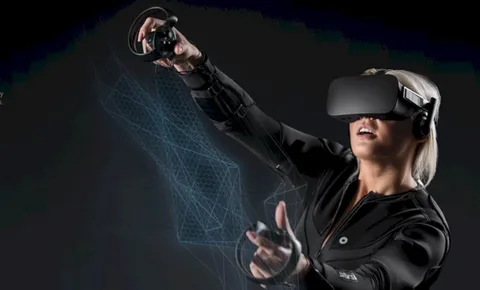In the ever-evolving realm of virtual reality (VR) gaming, the pursuit of an unparalleled immersive experience has led to groundbreaking innovations. One such innovation that has transformed the way we perceive and interact with virtual environments is Haptic Feedback. This technology, often described as the “next frontier” in gaming, goes beyond the visual and auditory dimensions, adding a tactile layer that elevates the gaming experience to new heights.
The Essence of Haptic Feedback
Engaging Your Senses
Haptic Feedback, in its essence, involves the use of advanced tactile feedback mechanisms to simulate the sense of touch within the virtual space. Imagine not only seeing and hearing the virtual world but feeling the subtle vibrations, textures, and forces as if they were real. This technology introduces an unprecedented level of immersion, bridging the gap between the digital and physical realms.
Dynamic Sensations
One of the key strengths of Haptic Feedback lies in its ability to convey a wide range of sensations. From the gentle caress of a breeze to the impactful recoil of a powerful weapon, the technology adapts in real-time to the virtual scenarios. This dynamic responsiveness enhances the overall gaming experience, making every moment feel authentic and engaging.
Evolution of Haptic Feedback in Gaming
Early Foundations
The roots of Haptic Feedback can be traced back to simple vibrations in early gaming controllers. However, contemporary advancements have taken this concept to unprecedented levels. Modern VR systems integrate a sophisticated array of actuators and sensors that work in tandem to deliver nuanced haptic sensations.
Precision and Realism
The current pinnacle of Haptic Feedback technology lies in its precision. Developers now have the ability to map specific sensations to distinct in-game events with unparalleled accuracy. Whether it’s the sensation of raindrops falling or the palpable thud of footsteps, the level of realism achieved through Haptic Feedback is astonishing.
The Impact on Gaming Experience
Immersive Storytelling
Haptic Feedback isn’t just a technological marvel; it’s a game-changer for narrative-driven experiences. Picture yourself exploring a virtual world where you can feel the heartbeat of your character during intense moments or sense the terrain beneath your virtual feet. This level of immersion revolutionizes the storytelling potential of VR games.
Enhanced Skill Development
Beyond storytelling, Haptic Feedback contributes to skill development in gaming. The subtle feedback from the controller can provide vital cues, helping players improve their reflexes and spatial awareness. This adds a layer of skill refinement that traditional gaming experiences lack.
Future Prospects and Integration
Cross-Platform Integration
As Haptic Feedback continues to evolve, its integration into various gaming platforms is becoming more seamless. From VR headsets to gaming consoles and even mobile devices, developers are actively exploring ways to bring this immersive technology to a broader audience.
Innovation Beyond Gaming
The applications of Haptic Feedback extend beyond gaming. Industries such as healthcare, education, and virtual training are increasingly adopting this technology to create realistic simulations for training and therapy.
Making the Right Choice for Your VR Setup
Compatibility and Considerations
For gamers looking to delve into the world of Haptic Feedback, understanding compatibility and system requirements is crucial. Different VR systems may offer varied levels of haptic capabilities, and choosing the right setup for your gaming preferences is essential.
Top Haptic Feedback VR Systems
- Oculus Rift S: Renowned for its precise haptic feedback and ergonomic design, the Oculus Rift S provides a stellar VR experience.
- Valve Index: With a robust haptic system, the Valve Index offers a high-fidelity VR experience for enthusiasts seeking top-tier immersion.
- PlayStation VR: Tailored for console gamers, the PlayStation VR system integrates haptic feedback seamlessly with the PlayStation gaming ecosystem.
Conclusion
In the dynamic landscape of VR gaming, Haptic Feedback stands as a testament to the relentless pursuit of realism and immersion. As the technology continues to advance, it not only reshapes the gaming experience but also opens doors to applications that extend beyond the gaming realm. For those seeking the epitome of virtual immersion, embracing Haptic Feedback is a journey into a future where the line between the real and the virtual becomes increasingly indistinguishable.


